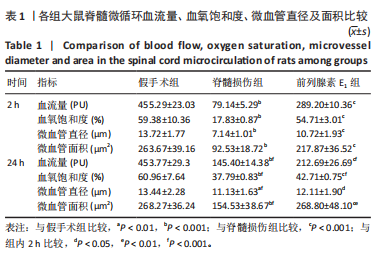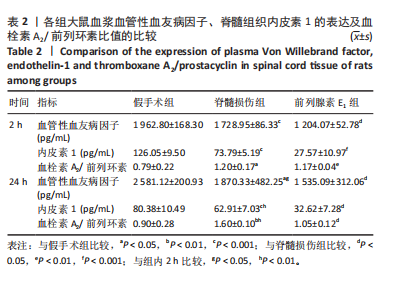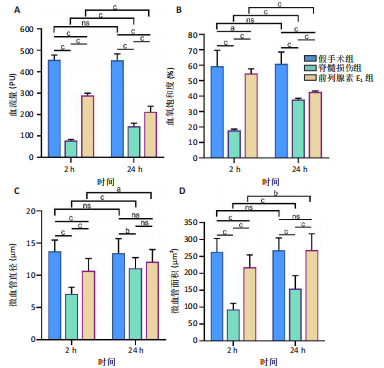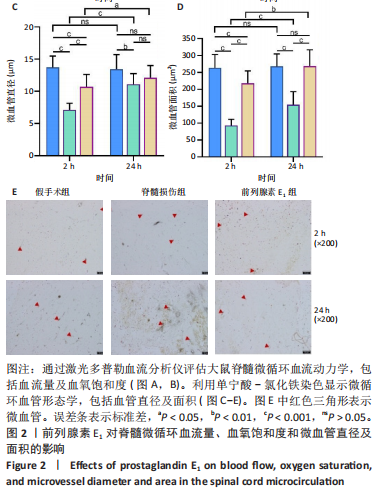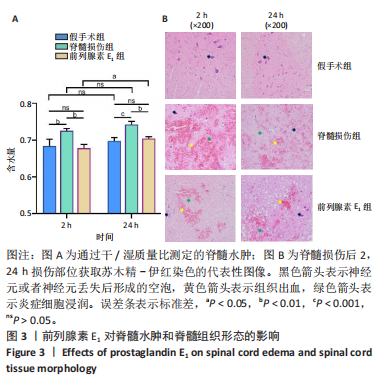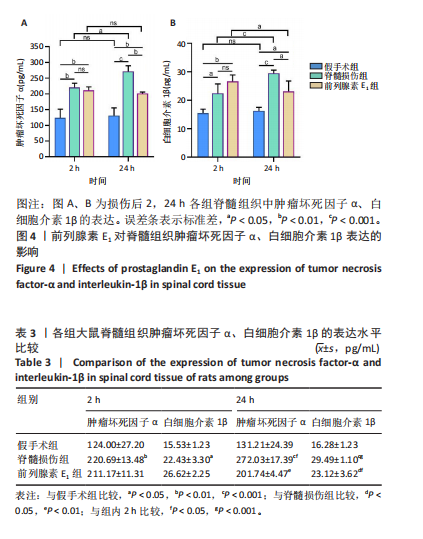[1] KARSY M, HAWRYLUK G. Modern Medical Management of Spinal Cord Injury. Curr Neurol Neurosci Rep. 2019;19(9):65-67.
[2] SOFRONIEW MV. Dissecting Spinal Cord Regeneration. Nature (London). 2018;557(7705):343-350.
[3] JANI RH, PRABHU AV, ZHOU JJ, et al. Citation Analysis of the Most Influential Articles On Traumatic Spinal Cord Injury. J Spinal Cord Med. 2020;43(1):31-38.
[4] SANDEAN D. Management of Acute Spinal Cord Injury: A Summary of the Evidence Pertaining to the Acute Management, Operative and Non-Operative Management. World J Orthop. 2020;11(12): 573-583.
[5] SEKHON LHS, FEHLINGS MG. Epidemiology, Demographics, and Pathophysiology of Acute Spinal Cord Injury. Spine (Philadelphia, Pa. 1976). 2001;26(24):S2-S12.
[6] XIN W, QIANG S, JIANING D, et al. Human Bone Marrow Mesenchymal Stem Cell-Derived Exosomes Attenuate Blood-Spinal Cord Barrier Disruption Via the Timp2/Mmp Pathway After Acute Spinal Cord Injury. Mol Neurobiol. 2021;58(12):6490-6504.
[7] TATOR CH, FEHLINGS MG. Review of the Secondary Injury Theory of Acute Spinal Cord Trauma with Emphasis On Vascular Mechanisms. J Neurosurg. 1991;75(1):15-26.
[8] ALIZADEH A, DYCK SM, KARIMI-ABDOLREZAEE S. Traumatic Spinal Cord Injury: An Overview of Pathophysiology, Models and Acute Injury Mechanisms. Front Neurol. 2019;10:282.
[9] WANG X, JIANG C, ZHANG Y, et al. The Promoting Effects of Activated Olfactory Ensheathing Cells On Angiogenesis After Spinal Cord Injury through the Pi3K/Akt Pathway. Cell Biosci. 2022;12(1):23.
[10] MARCOLINA A, VU K, ANNASWAMY TM. Lumbar Spinal Stenosis and Potential Management with Prostaglandin E1 Analogs. Am J Phys Med Rehabil. 2021;100(3):297-302.
[11] XIE X, LU W, CHEN Y, et al. Prostaglandin E1 Alleviates Cognitive Dysfunction in Chronic Cerebral Hypoperfusion Rats by Improving Hemodynamics. Front Neurosci. 2019;13:549.
[12] LIU L, ZHANG H, SHI Y, et al. Prostaglandin E1 Improves Cerebral Microcirculation through Activation of Endothelial Nos and Grpch1. J Mol Neurosci. 2020;70(12):2041-2048.
[13] HAMAMOTO Y, OGATA T, MORINO T, et al. Prostaglandin E1 Analog Increases Spinal Cord Blood Flow at the Point of Compression During and After Experimental Spinal Cord Injury. Spinal Cord. 2010;48(2): 149-153.
[14] COHEN J. Statistical Power Analysis for the Behavioral Sciences (Revised Edition). Laurence Erlbaum Associates: Hillsdale, NJ, USA. 1987.
[15] SUZUKI T, OBATA R, INOUE T, et al. Intravenous Lipo-Prostaglandin E1 Administration for Patients with Acute Central Retinal Artery Occlusion. BMJ Open Ophthalmol. 2022;7(1):e001014.
[16] SHEN J, CAO M, ZHOU T, et al. PgE1 Triggers Nrf2/Ho-1 Signal Pathway to Resist Hemin-Induced Toxicity in Mouse Cortical Neurons. Ann Transl Med. 2021;9(8):634.
[17] WANG J, TANG S, XIE Y, et al. Lipid Microsphere-Coated PgE1 Improves Peritoneal Transport and Reduces Inflammation in Peritoneal Dialysis: A Randomized Clinical Pilot Trial. Semin Dial. 2021;34(3):235-244.
[18] LI J, WANG B, WANG Y, et al. Therapeutic Effect of Liposomal Prostaglandin E(1) in Acute Lower Limb Ischemia as an Adjuvant to Hybrid Procedures. Exp Ther Med. 2013;5(6):1760-1764.
[19] MACHADO-ALBA JE, MACHADO-DUQUE ME. Use of Intravenous Alprostadil in Patients with Severe Critical Ischemia of the Lower Limbs. Vascular. 2019;27(3):318-323.
[20] ERAIFEJ J, NNADI C, GANAU M. Early and Ultra-Early Surgical Decompression for Acute Spinal Cord Injury: Bracing for the Winds of Change. Eur Spine J. 2022;31(7):1691-1692.
[21] YE J, WEN Z, WU T, et al. Single-Cell Sequencing Reveals the Optimal Time Window for Anti-Inflammatory Treatment in Spinal Cord Injury. Adv Biol (Weinh). 2023;7(10):e2300098.
[22] KAWATA K, MORIMOTO T, OHASHI T, et al. Experimental Study of Acute Spinal Cord Injury: A Histopathological Study. No Shinkei Geka. 1993;21(1):45-51.
[23] WALLACE MC, TATOR CH, FRAZEE P. Relationship Between Posttraumatic Ischemia and Hemorrhage in the Injured Rat Spinal Cord as Shown by Colloidal Carbon Angiography. Neurosurgery. 1986;18(4):433-439.
[24] ROOZBEHI A, JOGHATAIE MT, MEHDIZADEH M, et al. The Effects of Cyclosporin-a On Functional Outcome and Axonal Regrowth Following Spinal Cord Injury in Adult Rats. Acta Med Iran. 2012;50(4):226-232.
[25] YAO C, CAO X, YU B. Revascularization After Traumatic Spinal Cord Injury. Front Physiol. 2021;12:631500.
[26] MARCUS ML, HEISTAD DD, EHRHARDT JC, et al. Regulation of Total and Regional Spinal Cord Blood Flow. Circ Res. 1977;41(1):128-134.
[27] QIN L, WANG Y, XIE Z, et al. The Role of Et-1 in Early Cerebral Microcirculation Changes After Subarachnoid Hemorrhage. J Healthc Eng. 2022;2022:4592986.
[28] FREYERMUTH-TRUJILLO X, SEGURA-URIBE JJ, SALGADO-CEBALLOS H, et al. Inflammation: A Target for Treatment in Spinal Cord Injury. Cells. 2022;11(17):2692.
[29] JIANG T, QIN T, GAO P, et al. Sirt1 Attenuates Blood-Spinal Cord Barrier Disruption After Spinal Cord Injury by Deacetylating P66Shc. Redox Biol. 2023;60:102615.
[30] YUAN X, WU Q, WANG P, et al. Exosomes Derived From Pericytes Improve Microcirculation and Protect Blood-Spinal Cord Barrier After Spinal Cord Injury in Mice. Front Neurosci. 2019;13:319.
[31] MANZ XD, BOGAARD HJ, AMAN J. Regulation of Vwf (Von Willebrand Factor) in Inflammatory Thrombosis. Arterioscler Thromb Vasc Biol. 2022;42(11):1307-1320.
[32] ARISZ RA, de VRIES JJ, SCHOLS SEM, et al. Interaction of Von Willebrand Factor with Blood Cells in Flow Models: A Systematic Review. Blood Adv. 2022;6(13):3979-3990.
[33] ISHIHARA J, ISHIHARA A, STARKE RD, et al. The Heparin Binding Domain of Von Willebrand Factor Binds to Growth Factors and Promotes Angiogenesis in Wound Healing. Blood. 2019;133(24):2559-2569.
[34] LI X, LUO D, HOU Y, et al. Sodium Tanshinone Iia Silate Exerts Microcirculation Protective Effects Against Spinal Cord Injury in Vitro and in Vivo. Oxid Med Cell Longev. 2020;2020:3949575.
[35] IMIG JD. Eicosanoid Blood Vessel Regulation in Physiological and Pathological States. Clin Sci (Lond). 2020;134(20):2707-2727.
[36] DEMOPOULOS HB, FLAMM ES, PIETRONIGRO DD, et al. The Free Radical Pathology and the Microcirculation in the Major Central Nervous System Disorders. Acta physiol Scand Suppl. 1980;492:91-119.
[37] BRAUNE S, KÜPPER J, JUNG F. Effect of Prostanoids On Human Platelet Function: An Overview. Int J Mol Sci. 2020;21(23):9020.
[38] MAMO YA, ANGUS JA, ZIOGAS J, et al. The Role of Voltage-Operated and Non-Voltage-Operated Calcium Channels in Endothelin-Induced Vasoconstriction of Rat Cerebral Arteries. Eur J Pharmacol. 2014;742:65-73.
[39] A JC, LI ZY, LONG QF, et al. Mir-379-5P Improved Locomotor Function Recovery After Spinal Cord Injury in Rats by Reducing Endothelin 1 and Inhibiting Astrocytes Expression. Eur Rev Med Pharmacol Sci. 2019;23(22):9738-9745.
[40] JIN LY, LI J, WANG KF, et al. Blood-Spinal Cord Barrier in Spinal Cord Injury: A Review. J Neurotrauma. 2021;38(9):1203-1224.
[41] ZHOU ZL, XIE H, TIAN XB, et al. Microglial depletion impairs glial scar formation and aggravates inflammation partly by inhibiting STAT3 phosphorylation in astrocytes after spinal cord injury. Neural Regen Res. 2023;18(6):1325-1331.
[42] LI Z, ZHAO J, LI S, et al. Blocking the Egfr/P38/Nf-Κb Signaling Pathway Alleviates Disruption of Bscb and Subsequent Inflammation After Spinal Cord Injury. Neurochem Int. 2021;150:105190.
[43] CAI X, ZHAO J, LU Y, et al. The Microenvironment Following Oxygen Glucose Deprivation/Re-Oxygenation-Induced Bscb Damage in Vitro. Brain Res Bull. 2018;143:171-180.
[44] XU Z, XU W, CHEN X, et al. Study On Vascular Remodeling, Inflammatory Response, and their Correlations in Acute Spinal Cord Injury in Rats. Zhongguo xiufu chongjian waike zazhi. 2020;34(11):1429-1437.
[45] YUN J. Interleukin-1Β Induces Pericyte Apoptosis Via the Nf-Κb Pathway in Diabetic Retinopathy. Biochem Biophys Res Commun. 2021;546: 46-53.
[46] SHARMA HS. A Combination of Tumor Necrosis Factor-Alpha and Neuronal Nitric Oxide Synthase Antibodies Applied Topically Over the Traumatized Spinal Cord Enhances Neuroprotection and Functional Recovery in the Rat. Ann N Y Acad Sci. 2010;1199:175-185.
[47] SHARMA HS, WINKLER T, STÅLBERG E, et al. Topical Application of Tnf-Alpha Antiserum Attenuates Spinal Cord Trauma Induced Edema Formation, Microvascular Permeability Disturbances and Cell Injury in the Rat. Acta Neurochir Suppl. 2003;86:407-413.
[48] AUBERT JD, JUILLERAT-JEANNERET L. Endothelin-Receptor Antagonists Beyond Pulmonary Arterial Hypertension: Cancer and Fibrosis. J Med Chem. 2016;59(18):8168-8188.
[49] LIU L, ZHANG H, SHI Y, et al. Prostaglandin E1 Improves Cerebral Microcirculation through Activation of Endothelial Nos and Grpch1. J Mol Neurosci. 2020;70(12):2041-2048.
[50] LIU B, ZHANG S, XIONG X, et al. Lipo‑Prostaglandin E1 Modifies Cognitive Impairment in Rats with Vascular Cognitive Impairment by Promoting Angiogenesis Via the Vegf/Vegfr Pathway. Mol Med Rep. 2017;16(3):3117-3124.
[51] NAIMUSHIN YA, MAZUROV AV. Von Willebrand Factor Can Support Platelet Aggregation Via Interaction with Activated Gpiib-Iiia and Gpib. Platelets. 2004;15(7):419-425.
[52] ZDROJOWY K, ADAMIEC R, CZARNACKI M. New Aspects of Prostaglandin E1 Therapeutic Influence in Thrombo-Angiitis Obliterans. Pol Arch Med Wewn. 2002;108(5):1071-1077.
[53] ITOH Y, YASUI T, KAKIZAWA H, et al. The Therapeutic Effect of Lipo PgE1 On Diabetic Neuropathy-Changes in Endothelin and Various Angiopathic Factors. Prostaglandins Other Lipid Mediat. 2001;66(3):221-234.
[54] LIU HJ, MA JW, QIAO ZY, et al. Study of Molecular Mechanism of Prostaglandin E1 in Inhibiting Coronary Heart Disease. Mol Biol Rep. 2013;40(12):6701-6708.
[55] ZHANG L, WANG X, SI H. Synergistic Anti-Inflammatory Effects and Mechanisms of the Combination of Resveratrol and Curcumin in Human Vascular Endothelial Cells and Rodent Aorta. J Nutr Biochem. 2022;108:109083.
[56] VIRTUOSO A, DE LUCA C, KORAI SA, et al. Neuroinflammation and glial activation in the central nervous system: a metabolic perspective. Neural Regen Res. 2023;18(5):1025-1026.
[57] LIU S, GAN N, XIE J, et al. Clinical Evaluation of Alprostadil Combined with Nimodipine in Treatment of Cerebral Vasospasm After Subarachnoid Hemorrhage in Elderly Patients. Pak J Med Sci. 2023; 39(3):682-686.
[58] TSAI CH, HUANG PJ, LEE IT, et al. Correction for: Endothelin-1-Mediated Mir-Let-7G-5P Triggers Interlukin-6 and Tnf-Alpha to Cause Myopathy and Chronic Adipose Inflammation in Elderly Patients with Diabetes Mellitus. Aging (Albany NY). 2023;15(1):287.
[59] GÜR FM, BILGIÇ S. A Synthetic Prostaglandin E1 Analogue, Misoprostol, Ameliorates Paclitaxel-Induced Oxidative Damage in Rat Brain. Prostaglandins Other Lipid Mediat. 2022;162:106663.
[60] 李雪梅. 前列地尔注射液单次及双次给药对大鼠心肌缺血再灌注损伤的保护作用对比研究[D].长春:吉林大学,2016.
[61] 曹先德, 郑慧敏, 万春平. 前列腺素E1联合缺血预处理对肾部分切除术肾缺血再灌注损伤的机制研究[J]. 交通医学,2019;33(2): 119-122, 125.
[62] 戴伟娟, 朱凡河, 张国安, 等. 前列腺素E1对大鼠全脑缺血-再灌注损伤细胞凋亡及Caspase-3表达的影响[J]. 济宁医学院学报, 2017;40(2):98-102.
|
